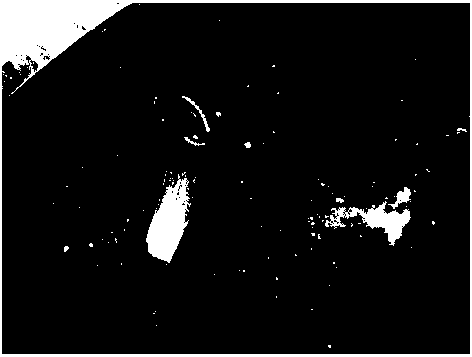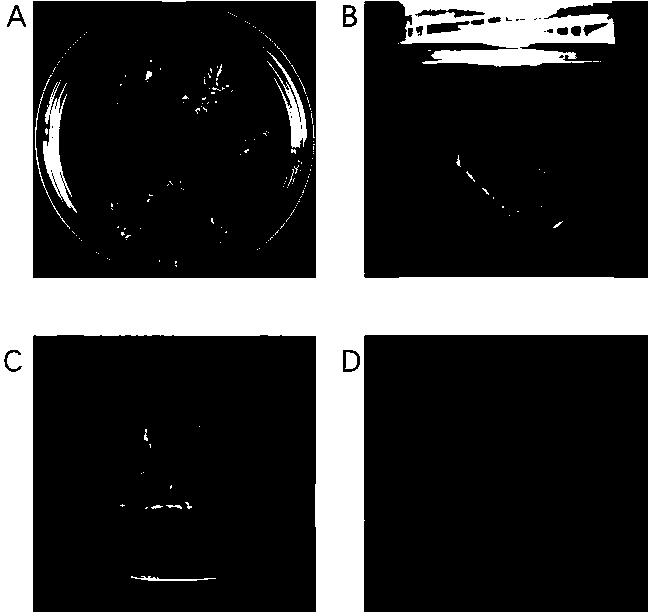High-efficiency regeneration method using cunninghamia lanceolata cotyledon as explant
A high-efficiency regeneration and explant technology, applied in the field of plant breeding and reproduction, can solve the problems of insufficient genetic transformation and large-scale reproduction, browning to reduce the regeneration frequency, and no transgenic plants are obtained, and achieve a good regeneration system, convenient material acquisition and cost. low effect
- Summary
- Abstract
- Description
- Claims
- Application Information
AI Technical Summary
Problems solved by technology
Method used
Image
Examples
Embodiment 1
[0025] A kind of high-efficiency regeneration method taking Chinese fir cotyledons as explants, it comprises the steps:
[0026] 1) Sowing: Select mature and plump seeds, soak them in tap water for 24 hours, and then sow them in a mixture of nutrient soil, vermiculite and perlite at a ratio of 2:2:1 (v / v) at room temperature (25±2°C). in the matrix;
[0027] 2) Disinfection: 20 days after the seeds germinate, select healthy seedlings and clean them with tap water. After removing the roots, soak them in 75vol% alcohol for 30 seconds, 0.1vol% mercuric chloride solution for 5 minutes, and rinse them with sterile water for 5 times;
[0028] 3) Induction culture: the cotyledons of the sterilized seedlings were taken as explants, and inoculated on the induction medium, under the light rate of 80 μmol·m -2 ·s -1 , light time 16 h / d, and culture temperature 25±2°C for 30 days to obtain adventitious buds; the formulation of the induction medium is: DCR+NAA 0.2 mg / L+TDZ 0.005 mg / L+6- ...
Embodiment 2
[0034] A kind of high-efficiency regeneration method taking Chinese fir cotyledons as explants, it comprises the steps:
[0035] 1) Sowing: Select mature and plump seeds, soak them in tap water for 24 hours, and then sow them in a mixture of nutrient soil, vermiculite and perlite at a ratio of 2:2:1 (v / v) at room temperature (25±2°C). in the matrix;
[0036] 2) Disinfection: 20 days after the seeds germinate, select healthy seedlings and clean them with tap water. After removing the roots, soak them in 75vol% alcohol for 45 seconds, soak them in 0.1vol% mercuric chloride solution for 6 minutes, and rinse them with sterile water for 5 times;
[0037] 3) Induction culture: the cotyledons of the sterilized seedlings were taken as explants, and inoculated on the induction medium, under the light rate of 80 μmol·m -2 ·s -1 , light time 16 h / d, and culture temperature 25±2°C for 30 days to obtain adventitious buds; the formulation of the induction medium is: DCR+NAA 0.2 mg / L+TDZ 0...
Embodiment 3
[0043] A kind of high-efficiency regeneration method taking Chinese fir cotyledons as explants, it comprises the steps:
[0044] 1) Sowing: Select mature and plump seeds, soak them in tap water for 24 hours, and then sow them in a mixture of nutrient soil, vermiculite and perlite at a ratio of 2:2:1 (v / v) at room temperature (25±2°C). in the matrix;
[0045] 2) Disinfection: 20 days after the seeds germinate, select healthy seedlings and clean them with tap water. After removing the roots, soak in 75vol% alcohol for 1 minute, 0.1vol% mercury chloride solution for 7 minutes, and rinse with sterile water for 5 times;
[0046] 3) Induction culture: the cotyledons of the sterilized seedlings were taken as explants, and inoculated on the induction medium, under the light rate of 80 μmol·m -2 ·s -1 , light time 16 h / d, and culture temperature 25±2°C for 30 days to obtain adventitious buds; the formulation of the induction medium is: DCR+NAA 0.2 mg / L+TDZ 0.005 mg / L+6- BA 1.0mg / L; ...
PUM
 Login to View More
Login to View More Abstract
Description
Claims
Application Information
 Login to View More
Login to View More - R&D
- Intellectual Property
- Life Sciences
- Materials
- Tech Scout
- Unparalleled Data Quality
- Higher Quality Content
- 60% Fewer Hallucinations
Browse by: Latest US Patents, China's latest patents, Technical Efficacy Thesaurus, Application Domain, Technology Topic, Popular Technical Reports.
© 2025 PatSnap. All rights reserved.Legal|Privacy policy|Modern Slavery Act Transparency Statement|Sitemap|About US| Contact US: help@patsnap.com



